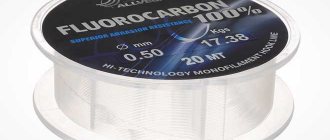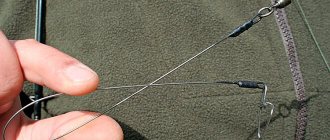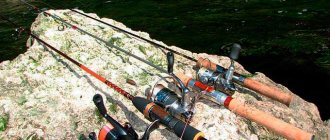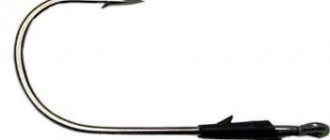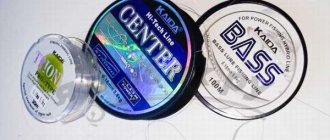The high thermal insulation properties of a wetsuit for spearfishing and its ability to protect the swimmer from hypothermia depend not only on the material, but also on how well it fits to the body. The equipment should fit as tightly as possible to the figure, but at the same time not hinder movement. Accordingly, the process of putting on overalls for spearfishing has some features and requires a certain skill from the diver.
The algorithm for putting on a wetsuit differs depending on whether you are using “wet” or “dry” type equipment. But in any case, a flashlight, mask, knife and other equipment necessary for diving should be prepared in advance, since it will be inconvenient to look for these little things in rubber armor.
Technology of putting on a wetsuit
This type of equipment is made of foam rubber - neoprene. These overalls do not have a lining, and the material does not glide well on the skin, so if handled carelessly, it can be torn. It is necessary to pull the material evenly without jerking; it is best to straighten the folds from the inside by threading your hand inside the sleeves or trouser legs. And for better glide over the body, the neoprene from the inside should be moistened with a soap solution.
If your skin is prone to allergic reactions, prolonged contact with soap may cause burning, redness and itching. Instead of soap, in this case it is better to use baby shampoo diluted with water or even baby oil. In the summer, a jumpsuit soaked in cool water will not cause any discomfort, but in winter, touching the body with wet and cold material will be very uncomfortable. A simple precaution will help you avoid this: to dilute the soap solution, you need to use warm water, which you put in a thermos in advance and don’t forget to take with you.
Before putting on the equipment, its inner surface must be evenly and thoroughly moistened with soapy water so that there are no dry areas left. Then experienced spearfishers recommend wrapping your arms and legs in plastic bags one at a time and threading them through your sleeves and pant legs. Next, the overalls need to be gradually pulled over the body, avoiding sudden jerks, and the folds straightened out. After the overalls fit completely, you need to fasten it and attach the diving equipment to it.
Special rules
The wetsuit must not be wet. If the suit is initially wet, putting it on will be much more difficult;
- The initial stage is to unfasten the wetsuit;
- Next, first of all, put the wetsuit on your legs;
- Until the legs are finally fixed, there is no need to put the suit on the rest of the body;
- Next, we fix the suit on our hands;
- Then you need to lift the wetsuit directly to the body. Bend down and slowly lift the neoprene, which is located at the level of the pelvic area. During work, the wetsuit may fall a little, but there is a guarantee that it will definitely not rise;
- Fasten your wetsuit properly;
- Be sure to fasten the Velcro at the back. But, first of all, it should be comfortable for the neck, do not fasten it too tightly;
- Final point: Pull the suit up from the back, to do this ask your trainer or partner for help.
Adding to all of the above, it is worth determining the selected suit size. To do this, you should raise your hands up, you should be as comfortable and free as possible, so that nothing constrains or limits your movements. With your arms down, the suit will slightly tighten your body and straighten your posture; this is within normal limits. Most importantly, do not forget that putting on a wetsuit correctly is the key to success.
Drysuit donning technique
If a “wet” diving suit for spearfishing retains body heat due to the thermal insulation properties of the layer of water located inside, then a “dry” one - due to the insulating properties of the material itself. This outfit is lined and fits less snugly, making it much easier to put on. In particular, you can do without soap solution, making the process of putting on overalls much more comfortable.

Otherwise, you should follow the same rules as in the case of “wet” models: do not apply uneven force to the material, carefully straighten the folds. It is worth remembering that when diving in “dry” equipment, wear underwear or thermal underwear underneath, and special socks on your feet.
HOW TO WEAR A WETSUIT CORRECTLY
It is better to put on your wetsuit in advance, spending some time on it before the start, rather than hastily putting it on at the last minute. Below are some tips to help you cope with this task.
* Pull the plastic bag over your leg as if it were a sock (do not wear a regular sock, this creates unnecessary friction), then put on the wetsuit as if it were regular skinny pants. Once your foot slides into the pant leg, remove the bag. Repeat the same with the second leg.
* Slowly pull the wetsuit fabric up, evenly distributing it from the ankles to the groin area. To make this easier, use ordinary gardening gloves with rubber inserts. Be careful not to accidentally tear your wetsuit with sharp nails.
* Pull the suit leg higher so that your shins remain exposed by about 10 cm. This will allow the suit to be pulled fairly tightly in the groin area. If your suit is loose in this area, you will have trouble moving through the transition zone and your hip flexors will be overworked while swimming.
* Repeat the trick with the plastic bag for the arms, pull the suit over the shoulders, also leaving about 5 cm bare around each wrist.
* Before fastening the suit, ask a friend to “push” you into it from the back, putting one hand inside the suit from the back, and the other gently pulling it over your shoulders. This will take a few extra minutes, but it will be worth it: your shoulders will feel much freer afterwards.
* As your friend zips up, squeeze your shoulder blades together and lower them down
* Finally, take courage and, when you first enter the water, run some water inside the suit through its neck. This will provide natural lubrication between the skin and the rubber suit, allowing you to move your upper torso more freely.
Use friction lubricant
When swimming in a wetsuit, the neck and armpits are often subject to friction, especially during sea or ocean swims - salt increases friction. Therefore, use a special lubricant for wetsuits.
Also, apply lubricant to your ankles and wrists for easy removal after your swim. Some swimmers have great difficulty taking off their wetsuit, and they deliberately “shorten” it, cutting off a few inches at the bottom, in the ankle area. Before you decide to take such a step, think: because of this, you will lose some buoyancy in your legs, and this loss will be irrevocable!
Paul Newsome: Personally, despite all the warnings from the manufacturers, I still use Vaseline or my favorite Bepanthen (moisturizing baby cream) as a lubricant. So what, I discovered America? If you are going to use an oil-based lubricant, you should definitely take the time to clean your suit after competition, otherwise the material will deteriorate and the suit will not last long.
Adam Young: You shouldn't resist the properties of the suit, you need to cooperate with them. Try modifying your sweep over the water, doing it with a straighter arm, like Kate did. This way you will avoid tension and premature fatigue of the deltoid muscles. If your arms and shoulders get tired while swimming in a wetsuit, think about whether you have tried using a classic carry? The solution to this problem has nothing to do with going to the gym, strength training, or building muscle mass, which, by the way, can only aggravate the situation. Instead, work on a relaxed, straight-arm swing. Among other things, this will provide a good distance between the hand and the surface during waves and ripples typical of open water.
WWW.WATERIA.RU
Types of wetsuits
There are many types of wetsuits. First of all, it is worth mentioning that suits can be dry or wet.
We also recommend reading:
How to properly tie a jig to a fishing line Diagram on how to learn how to tie a hook to a fishing line Tourist knots - types and methods of tying Gardner's loop for a feeder: how to tie
Dry suits are used by those who dive into water with temperatures below plus 5 Celsius. This is usually possible when swimming in winter , in Arctic waters, and so on. Under this suit, ordinary insulating clothing is worn, which prevents the swimmer from freezing. The wetsuit itself is put on top, the task of which is to prevent moisture from entering the body. If its shell is damaged, then all lower clothing instantly becomes wet and the person must immediately get out of the water.
Regular spearfishers require a wet suit. This is a completely different type of wetsuit, it performs different functions.
The suit is made of neoprene, which completely fits the skin, preventing moisture from penetrating. This type of wetsuit is the most common. In some cases, the inner surface of the clothing may have a special coating.
Properties of neoprene
Neoprene plays the main role in sewing a wetsuit. It is rubber filled with small pores with air. It is these small bubbles that become a protective barrier and prevent cold water from cooling the body.
The effectiveness of a wetsuit depends on the thickness of the neoprene layer. The thicker it is, the better it retains heat. Ideally, neoprene should adhere to the skin with its pores. Usually it is called that - an open-season wetsuit. If the suit has an inner lining, then the heat retention effect is reduced.
Neoprene in its pure form has a smooth surface. This allows a hunter or swimmer to move faster underwater. A person wearing a neoprene suit and being in the water does not feel it on his body. But maneuverability increases significantly. If the suit is accidentally damaged, then the water disturbs the swimmer only in the place where the seal is broken. Water does not penetrate into the wetsuit and does not cool the entire body.
However, a wetsuit can be made from other materials. The outside of this clothing can be covered with protective fabric, nylon, and so on.
How to choose a wetsuit
Before choosing a wetsuit for spearfishing, you must immediately decide what it is for and what time of year it will be used. Many people strive to purchase suits with fabric lining. They are easier to put on, but they are only suitable for summer. However, practice shows that over time, hunters tend to dive into the water for prey both in autumn and early winter. To save money, it is better to immediately buy a universal suit. The following factors should be kept in mind:
- neoprene thickness;
- suit size;
- presence of open pores;
- the presence of additional devices;
- colors.
Wetsuits - what and why. Video
Wetsuits - what and why
My remote students who take video swimming courses often ask what the wetsuit I’m wearing is for, why do I always record classes in a wetsuit? Does it help you swim, keep you warm? There are several types of wetsuits, and each has its own purpose. Next I will talk in detail about each. Thin lycra wetsuit The suit you see on me now is made of thin and light lycra. Its function is to protect from the sun. It doesn't warm at all, quite the opposite. Often, new swimmers or parents of young new swimmers make the mistake of buying a Lycra suit to keep them warm in the water. If the water is cool, then such a wetsuit will only add to the discomfort. Water temperature and choice of wetsuit From my experience I can say that at a water temperature of +25...+28 °C no wetsuit is required, except a light one made of lycra that will protect against ultraviolet radiation. "Wet" short neoprene wetsuit
At a water temperature of +23...+24 °C, you can wear a short suit made of neoprene with a thickness of 1.5 mm. It does not hinder movement, but a little water gets into it, which is why it is called wet. However, water does not flow out of it, so the person feels comfortable. It is especially good to exercise in such a suit in the morning or evening. “Semi-dry” elongated neoprene suit If the water temperature drops to +18...+20 °C, then we put on an elongated neoprene wetsuit with a thickness of 2 - 3 mm. It has a special cuff in the neck area, which, when fastened, almost prevents water from penetrating inside. The small amount of water that can still leak out will not cause any discomfort. The “semi-dry” suit has another useful property - buoyancy. If you throw it on the water, it floats calmly. For those who are just learning to swim, such a wetsuit will help them stay afloat a little. “Dry” extended suit made of neoprene If the water temperature drops below +17 °C, you need to buy an extended wetsuit made of neoprene with a thickness of 5 - 7 mm. At water temperatures below +12 °C - 7 - 10 mm. These suits are designed in such a way that water does not penetrate inside, i.e. they are completely dry. In cold water, also use gyro helmets, water shoes and gloves. Cost of a Wetsuit You can buy extremely expensive branded wetsuits, but this is completely unnecessary in terms of comfort. For example, I have been buying wetsuits from Decathlon for several years now and am very pleased with the quality. If you handle them carefully, the suits can be used for a long time.
